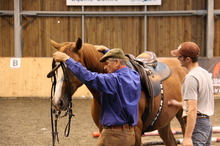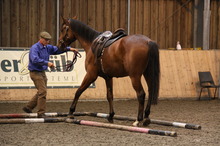On the 30th of August 2011 the scientific paper authored by Drs. Veronica Fowler, Mark Kennedy and David Marlin entitled ‘A comparison between the Monty Roberts technique and a conventional UK technique for initial training of riding horses’ was accepted for publication in Anthrozoös. Anthrozoös is a quarterly, peer-reviewed multidisciplinary journal reporting the interactions of people and animals, a journal which has enjoyed a distinguished history as a pioneer in the field since its launch in 1987. Prior to appearing in print in Anthrozoös the study will be presented at the International Society of Equitation Science (ISES) having been accepted by the scientific committee and also presented at the Centre for Animal Welfare & Anthrozoology, Department of Veterinary Medicine University of Cambridge both in October this year.
Comment from Dr. Veronica Fowler
“This study describes a comparison of the efficacy of the Monty Roberts horsemanship technique in comparison to a UK conventional training technique for the initial training of horses. Initial training of young horses, in particular the first time a horse is saddled and ridden has been recently reported in the scientific literature as a significant stressor in terms of the impact on the welfare of the horse. It is therefore vital that we fully evaluate the techniques which are practiced around the world to identify those which have the potential to cause compromised welfare and suffering during foundation training of horses.

Monty Roberts bridling horse with rider Jared Huhta standing by
Note the heart rate monitor on the pictured horse. The monitor was used to determine the stress level during basic training exercises.
Courtesy Monty and Pat Roberts Inc. archive
Our study reports that horses trained using Monty Robert’s methods had significantly lower maximum heart rates (bpm) during both first saddle and first rider when compared to a UK conventional training method. Monty Roberts trained horses did have significantly lower heart rates during first saddle and first rider backing process (i.e. heart rate reduced between first saddle and first rider), a finding which has never previously been reported in the scientific literature. Thus the heart rates observed from Monty Roberts trained horses during first saddle and first rider are currently the lowest reported for any training regime reported in the literature to date.
The use of the round pen and in particular the technique of Join-up have been frequently criticized and reported in the literature to be another significant stressor due to the perceived opinion that this environment and method overtly activates the flight response. Our study could find no evidence that the use of the round pen or, indeed the technique of Join-up, was fear inducing and thus a significant stressor to the horse based on heart rate alone. In fact, we found that the heart rate of horses during this technique were considerably below the maximum heart rate for horses of this age and breed.
Following 20 days of training (30 minutes/horse/day) the study horses undertook a standardized ridden obstacle and flatwork test and a ridden freestyle test. Heart rates recorded during these tests for both training regimes were not significantly different; however Monty Robert’s trained horses scored significantly higher in all three tests as determined by a panel of judges who were unaware of the study or the trainers involved in the study.
Our manuscript therefore provides peer reviewed scientific substance to indicate that that the Monty Roberts training technique is highly efficacious in terms of the effect on the welfare and performance of the horse undergoing foundation training.”
Recently, a student under the supervision of Professor P. McGreevy of the University of Sydney, Australia, set out to discredit round pen techniques, specifically Monty Roberts’ Join-Up® methods. This video demonstrates the explicit reasons behind the student’s paper in her own words, specifically mentioning Her Majesty The Queen of England. An abstract of that paper was presented at the International Society of Equitation Science (ISES) conference in Edinburgh, Scotland during their July conference.
Mr. Roberts responded that his Join-Up® method uses both positive and negative reinforcement, and negative reinforcement could be a ''good thing''.

Monty Roberts backing a horse while monitoring stress
Monty Roberts' Join-Up® techniques create a bond between trainer and horse similar to bond created within a herd structure.
Courtesy Monty and Pat Roberts Inc. archive
''How do you get a horse to move off your leg? You lay your leg against the horse with pressure and then when the horse steps away you remove the pressure - that's negative reinforcement,'' said Mr. Roberts, who advocates non-violence and uses choice without pain or force in the training of horses in front of live audiences worldwide.
''Everybody that ever works with a horse stresses a horse. You will stress a horse when you bring him out of a meadow,'' said Mr. Roberts, who will visit Australia next month. “They have to go through a certain amount of stress in order to accept they are going to live with humans”, he said.
Compare this student’s paper making the news in equestrian circles worldwide with a controlled Science Trial and published in a legitimate Science Journal Anthrozoös referenced by Fowler V. Kennedy M. and Marlin D. (2012) A Comparison of the Monty Roberts Technique with a Conventional UK technique for initial training of riding horses. Anthrozoös. Vol. 25 (3).
Here is a quote from one of the delegates of the ISES: "Re Round pen - oh, this does get a lot of people riled up [for want of a better word]"
About Monty Roberts
MONTY ROBERTS first gained widespread fame with the release of his New York Times Best Selling book, The Man Who Listens To Horses; a chronicle of his life and development of his non-violent horse training methods called Join-Up®. Monty grew up on a working horse farm as a firsthand witness to traditional, often violent methods of horse training and breaking the spirit with an abusive hand. Rejecting that, he went on to win nine world's championships in the show ring. Today, Monty's goal is to share his message that "Violence is never the answer." Roberts has been encouraged by Her Majesty Queen Elizabeth II as well as the ASPCA "Founders" award and the MSPCA George T. Angell Humanitarian Award. He recently launched his Equus Online University; an interactive online lesson site that is already being considered the most effective educational tool for horsemen on the web.
About Dr. Veronica Fowler
Dr. Veronica Fowler spent nine years at University gaining a BSc (Hons) in Animal Science (University of Reading), an MSc in Equine Science (Hartpury College) and a PhD in Infectious Diseases of Animals (Royal Veterinary College). Dr. Fowler now works as a Post-Doctoral Research Scientist at the Institute for Animal Health and as an Equine Science consultant specializing in equine behavior, welfare and physiology.
Dig deeperTM
Join-Up philosophies can be seen at work with both humans and horses across the world, from farms to major corporations. To learn more about Monty Roberts or the many applications of his Join-Up training methods, visit www.montyroberts.com.
